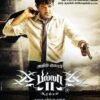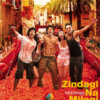Locations in Europe: London
Storyline
Star(s): Irrfan Khan, Radhika Madan, Kareena Kapoor, Deepak Dobriyal, Dimple Kapadia
Songs/Dance/Action Sequences: Located in London and India.
Indian/ International Crew: Indian and international.
Language: Hindi
Line Producer/Executive Producer/ Associate Producer: Vishal Bajaj (Executive Producer); Sudipto Sarkar (Line Producer for U.K); Kamlesh Mayuri (Production Coordinator, London)
Director/Producer: Homi Adajania (Director); Dinesh Vijan, Jyoti Deshpande (Producer); Smriti Jain (Supervising Producer)
Film Location Analysis
By Ranjani Mazumdar
Angrezi Medium depicts London through a sensibility that the director, Homi Adajania, believed shapes the immigrants' encounters with the city and country. Adajania is known for his fascination with dysfunctional families, friendships, and relationships, which he usually channels into absurdist situations. The absurdities can sometimes take the form of black comedy with a sinister edge, as in Being Cyrus (2005), and sometimes they are tinged with sentimental drama, as in Cocktail (2012). Angrezi Medium works with both comedy and drama, using elements of an absurdist style in the depiction of a simple relationship between Champak, a father from Udaipur, a small town in India, and his daughter Tarika’s aspirational dreams. This is mapped out across two very different kinds of spaces—Udaipur in Rajasthan and London in the UK, where Tarika wants to study after finishing school. While the two geographical spaces are distinctly different, Adajania ensures a full range of distinctly different sensibilities that are played out in both locations.
In the London segment, there is no desire to showcase the city’s iconic buildings. Instead, we see streets captured through moving cars, police station interiors, random street sites, the interiors of immigrant homes, shops, and ordinary grocery stores. In one moment of the film, Champak, Gopi, and Bablu are shown walking alongside a wall with graffiti. Adajania’s deliberate staging of this walk is a conscious spatial intervention, and at the end of the walk, we see a handwritten sign that says, "scrap metal." The use of these signs aid in the imagination of certain kinds of spaces in the city.
The only iconic space used is that of Royal Holloway University, which stands in for Truford, the dream university that Tarika wants to attend. Royal Holloway is shown a few times in the film, initially as a frontal low-angle shot to stage its architectural grandeur seen from Tarika’s wonderous eyes. There are no drone or aerial shots taken to display the scale of the building. Only ground-level perception can simulate the viewpoint of the character. The Founders building is perhaps the most well-known at Royal Holloway, and the university proudly asked people on Twitter to identify the use of the space in the trailer of Angrezi Medium. Royal Holloway has also been voted one of the most beautiful university buildings in the UK, an architectural trace of the Victorian era that includes a collection of Victorian paintings. The use of this space in Angrezi Medium is very different from the typical ways in which historic buildings are mobilised in the portrayal of the UK in films by Karan Johar. The university’s exorbitant fee structure and the difficulties faced by Tarika’s father and uncle in helping their daughter live her dream of studying in London are crucial to the film’s narrative, conveyed with humour, wit, and satire.
In a significant moment in the film, a fundraiser is held in the lush gardens of the university, with the buildings serving as a backdrop. Father and uncle bid money along with others, hoping to secure a seat as the highest bidder. Having achieved that position, there is a scramble to find the money to pay the university. With only a week’s deadline ahead of them, Champak and Gopi try their hands initially at gambling and betting. Finally, they decide to sell the name of the family, Ghasiteram, which is so dear to them. This play with fundraising for a place in the university against a family name of simple sweet shop owners is played out in the narrative as a networked movement between London and Udaipur. The absurdity of the sequences highlights the inequities in access to education and cultural capital.
It is interesting that while London is projected with little fanfare, Udaipur is sculpted with greater detail using drones for aerial views and street-level navigation through walks and rickshaw rides to enhance the texture of the terrain. There is a sense of nostalgia and humour associated with the space that is reflected in the camera work and editing. A small-town ecology and its quirky characters are identified, along with their dreams and aspirations. This part of the film connects with the rise of small-town India, or what is often referred to as the heartland in contemporary cinema. Within this space, a young woman’s aspirations are taken seriously by her father and other family members. From Champak’s point of view, however, London appears to be lacking in glory, which is why it is a city that is envisioned from the vantage point of the immigrant facing problems.
The climax of the film is a chase through the city when Naina is told by a fellow cop that they have received information about Champak and Gopi having picked up a lot of cash. The pickup is the money acquired through the sale of the family name but wired to someone who generates the amount in cash and hands it over in an old tyre yard. Then a car chase follows with Naina, who calls her mother for help and has the bag removed from the car to ensure Champak and Gopi do not get arrested. In the back and forth on the phone between Naina and Bablu, the driver of the car, Tarika learns of all the hardships faced by her father and uncle to get the money for her education at Truford. She decides to return to India. The chase ends with a brief action sequence in what is referred to in the film as the Brenton scrapyard. If an earlier walk against a graffiti-marked wall ended with a handwritten sign saying "scrap metal," here we see the production of scrap metal with the destruction and recycling of old cars. Unlike films like Zindagi Na Milegi Dobara (2011) and War (2019), the car is not a fetishised object in Angrezi Medium. Rather, the references to metal waste in the wall writing and in the space of the scrap yard deglamourize the car. It is this instinctive approach to the car that makes the geographical map of London in the film so different from many other Bombay films located in the city.
Additional Information & Links
The film was released five days before WHO declared Covid-19 a global pandemic. This resulted in the film not getting a theatrical release and affected the film’s box office performance.












